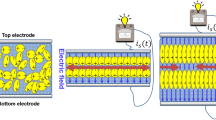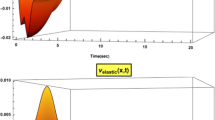Abstract
It is well known that magnetic energy of the piezoelectric beam is relatively small, and it does not change the overall dynamics. Therefore, the models, relying on electrostatic or quasi-static approaches, completely ignore the magnetic energy stored/produced in the beam. A single piezoelectric beam model without the magnetic effects is known to be exactly observable and exponentially stabilizable in the energy space. However, the model with the magnetic effects is proved to be not exactly observable/exponentially stabilizable in the energy space for almost all choices of material parameters. Moreover, even strong stability is not achievable for many values of the material parameters. In this paper, it is shown that the uncontrolled system is exactly observable in a space larger than the energy space. Then, by using a \(B^*\)-type feedback controller, explicit polynomial decay estimates are obtained for more regular initial data. Unlike the classical counterparts, this choice of feedback corresponds to the current flowing through the electrodes, and it matches better with the physics of the model. The results obtained in this manuscript have direct implications on the controllability/stabilizability of smart structures such as elastic beams/plates with piezoelectric patches and the active constrained layer (ACL) damped beams/plates.


Similar content being viewed by others
References
Alabau F, Cannarsa P, Komornik V (2002) Indirect internal stabilization of weakly coupled evolution equations. J Evol Equ 2–2:127–150
Alabau-Boussouira F, Lautaud M (2012) Indirect stabilization of locally coupled wave-type systems. ESAIM COCV 18–2:548–582
Alabau-Boussouira F (2003) A two-level energy method for indirect boundary observability and controllability of weakly coupled hyperbolic systems SIAM. J Control Optim 42–3:871–906
Ammar-Khodja F, Benabdallah A, Gonzlez-Burgos M, de Teresa L (2011) Recent results on the controllability of linear coupled parabolic problems: a survey. Math Control Relat Fields 1–3:267–306
Ammar Khodja F, Benabdallah A, Gonzlez-Burgos M, de Teresa L (2013) A new relation between the condensation index of complex sequences and the null controllability of parabolic systems. C R Math Acad Sci Paris 351(19–20):743–746
Ammari K, Tucsnak M (2001) Stabilization of second order evolution equations by a class of unbounded feedbacks. ESAIM COCV 6:361–386
Avdonin S, Moran W (2001) Ingham-type inequalities and Riesz bases of divided differences. Int J Appl Math Comput Sci 11–4:803–820
Avdonin S, Moran W (2002) Riesz bases of exponentials and divided differences. St Petersburg Math J 13–3:339–351
Baiocchi C, Komornik V, Loreti P (2002) Ingham-Beurling type theorems with weakened gap conditions. Acta Math Hungar 97:55–95
Banks HT, Smith RC, Wang Y (1996) Smart material structures: Modelling. Estimation and Control, Mason, Paris 1996
Baz A (1996) Active Constrained Layer Damping, US Patent # 5,485,053
Bégout P, Soria F (2007) A generalized interpolation inequality and its application to the stabilization of damped equations. J Differ Equ 240–2:324–356
Bernik VI, Dodson MM (1999) Metric Diophantine Approximation on Manifolds. Cambridge University Press, Cambridge
Cassels JW (1966) An Introduction to Diophantine Approximation. Cambridge University Press, Cambridge
Castro C, Zuazua E (1998) Boundary controllability of a hybrid system consisting in two flexible beams connected by a point mass. SIAM J Control Optim 36–5:1576–1595
Dager R, Zuazua E (2006) Wave propagation, Observation and Control in 1-d Flexible Multi-structures, Springer
Destuynder PH, Legrain I, Castel L, Richard N (1992) Theoretical, numerical and experimental discussion of the use of piezoelectric devices for control-structure interaction. Eur J Mech A Solids 11:181–213
Hansen SW (2004) Several Related Models for Multilayer Sandwich Plates. Math Models Methods Appl Sci 14–8:1103–1132
Hansen SW, Özer AÖ (2010) Exact boundary controllability of an abstract Mead-Marcus Sandwich beam model. In: The Proceedings of 49th IEEE Conf. on Decision & Control, Atlanta, USA, pp 2578–2583
Jaffard S, Tucsnak M (1997) Regularity of plate equations with control concentrated in interior curves. Proc R Soc Edinb Sect A 127:1005–1025
Jaffard S, Tucsnak M, Zuazua E (1998) Singular internal stabilization of the wave equation. J Differ Equ 145–1:184–215
Kapitonov B, Miara B, Menzala GP (2007) Boundary observation and exact control of a quasi-electrostatic piezoelectric system in multilayered media. SIAM J Control Optim 46–3:1080–1097
Komornik V, Loreti P (2005) Fourier Series in Control Theory. Springer, New York
Lions JL (1988) Exact Controllability, stabilization and perturbations for distributed parameter systems. SIAM Rev 30–1:1–68
Luca F, de Teresa L (2013) Control of coupled parabolic systems and Diophantine approximations. SEMA J 61:1–17
Miller SJ, Takloo-Bighash R (2006) An Invitation to Modern Number Theory. Princeton University Press, Princeton
Morris KA, Özer AÖ (2014) Comparison of stabilization of current-actuated and voltage-actuated piezoelectric beams. In: The Proceedings of 53rd IEEE Conference on Decision & Control, Los Angeles, USA, pp 571–576
Morris KA, Özer AÖ (2013) Strong stabilization of piezoelectric beams with magnetic effects. In: The Proceedings of 52nd IEEE Conference on Decision & Control, Firenze, Italy, pp 3014–3019
Morris KA, Özer AÖ (2014) Modeling and stabilizability of voltage-actuated piezoelectric beams with magnetic effects. SIAM J Control Optim 52–4:2371–2398
Özer AÖ, Hansen SW (2014) Exact boundary controllability results for a multilayer Rao-Nakra sandwich beam. SIAM J Control Optim 52–2:1314–1337
Özer AÖ, Hansen SW (2013) Uniform stabilization of a multi-layer Rao-Nakra sandwich beam. Evol Equ Control Theory 2–4:195–210
Özer AÖ, Morris KA (2014) Modeling an elastic beam with piezoelectric patches by including magnetic effects. In: The Proceedings of the American Control Conference, Portland, USA, pp 1045–1050
Rogacheva N (1994) The Theory of Piezoelectric Shells and Plates. CRC Press, Boca Raton
Russell DL (1986) The DirichletNeumann boundary control problem associated with Maxwells equations in a cylindrical region. SIAM J Control Optim 24:199–229
Scott WT (1940) Approximation to real irrationals by certain classes of rational fractions. Bull Am Math Soc 46:124–129
Smith RC (2005) Smart Material Systems: Model Development. SIAM, Philadelphia
Tiersten HF (1969) Linear piezoelectric plate vibrations. Plenum Press, New York
Triebel H (1978) Interpolation Theory, Function Spaces. Differential Operators, North-Holland, Amsterdam
Tucsnak M (1996) Regularity and exact controllability for a beam with piezoelectric actuator. SIAM J Control Optim 34:922–930
Tucsnak M (1996) Control of plate vibrations by means of piezoelectric actuators. Discret Contin Dyn Syst 2:281–293
Tucsnak M, Weiss G (2001) Simultaneous controllability in sharp time for two elastic strings. ESAIM Control Optim Calc Var 6:259–273
Tucsnak M, Weiss G (2009) Observation and Control for Operator Semigroups. Birkhuser Verlag, Basel
Tzou HS (1993) Piezoelectric shells, Solid Mechanics and Its applications 19. Kluwer Academic, The Netherlands
Ulrich D (1980) Divided Differences and Systems of Nonharmonic Fourier Series. Proc Am Math Soc 80(1):47–57
Yang J (2005) An Introduction to the Theory of Piezoelectricity. Springer, New York
Yang J (2006) A review of a few topics in piezoelectricity. Appl Mech Rev 59:335–345
Acknowledgments
I would like to thank to Prof. Kirsten Morris and Prof. Sergei Avdonin for the fruitful discussions and suggestions to finalize this paper.
Author information
Authors and Affiliations
Corresponding author
Appendix: Some results in number theory
Appendix: Some results in number theory
In this section, we briefly mention some fundamental results of Diophantine’s approximation. The theorem of Khintchine (Theorem 8) plays an important role to determine the Lebesgue measure of sets investigated in this paper.
Let \(f:\mathbb {N}\rightarrow \mathbb {R}^+\) be called an approximation function if
A real number \(\zeta \) is \(f\)-approximable if \(\zeta \) satisfies
for infinitely many rational numbers \(\frac{\tilde{p}}{\tilde{q}}.\) Let \(P(f)\) be the set of all \(f\)-approximable numbers. We recall the following theorem to find the measure of sets of type \(P(f).\)
Theorem 8
(Khintchine’s theorem) [13, Page4] Let \(\mu \) be the Lebesgue measure. Then
Dirichlet’s theorem [14] states that every irrational number can be approximated to the order 2. The following theorem from [35] is a special case of Dirichlet’s theorem:
Theorem 9
Let \(\zeta \in \mathbb {R}-\mathbb {Q}.\) Then there exists a constant \(C\ge 1,\) and increasing sequences of coprime odd integers \(\{\tilde{p}_j\},\{\tilde{q}_j\}\) satisfying the asymptotic relation
It obvious by Theorem 8 that the set \( \mathbb {R}-\mathbb {Q}\) is uncountable and it has a full Lebesgue measure.
Definition 5
A real number \(\zeta \) is a Liouville’s number if for every \(m\in \mathbb {N}\) there exists \(\frac{\tilde{p}_m}{\tilde{q}_m}\) with \(p_m, q_m \in \mathbb {Z}\) such that
It is proved that any Liouville’s number is transcendental. Theorem 8 implies that the set of Liouville’s numbers is of Lebesgue measure zero.
Definition 6
A real number \(\zeta \) is an algebraic number if it is a root of a polynomial equation
with each \(a_i \in \mathbb {Z},\) and at least one of \(a_i\) is non-zero. A number which is not algebraic is called transcendental.
Now we give the following results of Diophantine’s approximations:
Theorem 10
There exists a set \(\tilde{\mathbb {Q}}\) such that if \(\zeta \in \mathbb {R}-\tilde{\mathbb {Q}},\) then for every \(\varepsilon >0\) there are infinitely many \(\frac{\tilde{p}}{\tilde{q}}\in \mathbb {Q}\) and a constant \(C_\zeta >0\) such that
Moroever, \(\mu (\tilde{\mathbb {Q}})=0.\)
Proof
We know that the irrational algebraic numbers belong to \(\tilde{\mathbb {Q}}\) by Roth’s theorem (Page 103, [14]). Therefore \(\tilde{\mathbb {Q}}\) is not empty. We proceed to the second part of the lemma. The first part of the theorem implies that if \(\zeta \in \tilde{\mathbb Q}\) then for all \(C_\zeta >0,\) the inequality \(\left| ~\zeta -\frac{\tilde{p}}{\tilde{q}}~\right| < \frac{C_\zeta }{\tilde{q}^{2+\varepsilon }}\) holds for some \(\frac{\tilde{p}}{\tilde{q}}\in \mathbb {Q}.\) Now define the set
By the notation of Theorem 8, choose \(f(\tilde{q})=\frac{C_\zeta }{\tilde{q}^{2+\varepsilon }}\) so that \(\tilde{q} f(\tilde{q})\) is nonincreasing and \(\sum \nolimits _{\tilde{q}\in \mathbb {N}}\frac{C_\zeta }{\tilde{q}^{1+\varepsilon }}<\infty .\) By Theorem 8, \(\mu (\tilde{\mathbb Q}_{\varepsilon })=0. \) Now we prove \(\tilde{\mathbb {Q}}\subset \tilde{\mathbb Q}_{\varepsilon }\) by contradiction. Assume that \(\zeta \notin \tilde{\mathbb Q}_{\varepsilon }\), i.e., there are finitely many rationals \(\left\{ \frac{p_i}{q_i}\right\} _{i=1,\ldots , N}\) such that
The last inequality implies that \(\zeta \in \mathbb {R}-\mathbb {Q}.\) This implies that the set \(\mathbb {R}-\tilde{\mathbb {Q}}\) has a full Lebesgue measure. \(\square \)
Now define the set \(\tilde{\tilde{\mathbb {Q}}}\) by
If we consider numbers \(\zeta \in \mathbb {R}\) whose the partial quotients satisfy \(|a_k|<C(\zeta )\) for all \(k\in \mathbb {N}\) in its continued fraction expansion
then \(\zeta \in \tilde{\tilde{\mathbb {Q}}}.\) By Liouville’s theorem (Page 128, [26]), \(\tilde{\tilde{\mathbb {Q}}}\) also contains all quadratic irrational numbers (the roots of an algebraic polynomial of degree \(2\)). Therefore the set is uncountable.
Lemma 6
The set \(\tilde{\tilde{\mathbb {Q}}}\) has a Lebesgue measure zero.
Proof
Define the set \(F_m\) by
Then \(F_m\) has a full Lebesgue measure by Theorem 8, i.e., \(f(\tilde{q})=\frac{C}{m\tilde{q}^2},\) and \(\sum \nolimits _{\tilde{q}\in \mathbb {N}} {\tilde{q} f(\tilde{q})}=\infty .\) Now consider the set \(\bigcap \nolimits _{m\in \mathbb {N}} F_m.\) This set is the countable intersection of sets \(F_m,\) and each \(F_m\) has full Lebesgue measure. Therefore \(\mu \left( \bigcap \nolimits _{m\in \mathbb {N}} F_m\right) \) has full Lebesgue measure. Since \(\tilde{\tilde{\mathbb {Q}}}=\mathbb {R}-\bigcap \nolimits _{m\in \mathbb {N}} F_m,\) then \(\mu (\tilde{\tilde{\mathbb {Q}}})=0\). \(\square \)
Rights and permissions
About this article
Cite this article
Özer, A.Ö. Further stabilization and exact observability results for voltage-actuated piezoelectric beams with magnetic effects. Math. Control Signals Syst. 27, 219–244 (2015). https://doi.org/10.1007/s00498-015-0139-0
Received:
Accepted:
Published:
Issue Date:
DOI: https://doi.org/10.1007/s00498-015-0139-0




